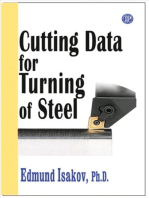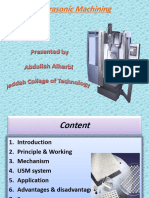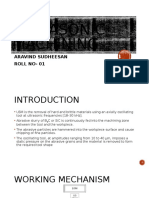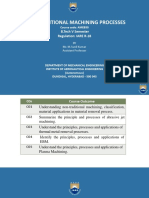Ultresonic Machining
Ultresonic Machining
Uploaded by
Prashant SinghCopyright:
Available Formats
Ultresonic Machining
Ultresonic Machining
Uploaded by
Prashant SinghCopyright
Available Formats
Share this document
Did you find this document useful?
Is this content inappropriate?
Copyright:
Available Formats
Ultresonic Machining
Ultresonic Machining
Uploaded by
Prashant SinghCopyright:
Available Formats
Ultrasonic machining
Schematic of the ultrasonic machining operation
Ultrasonic machining, also known as ultrasonic impact grinding,[1] is a machining operation in which an abrasive slurry freely flows between the workpiece and a vibrating tool.[2] It differs from most other machining operations because very little heat is produced.[2] The tool never contacts the workpiece and as a result the grinding pressure is rarely more than 2 pounds,[1] which makes this operation perfect for machining extremely hard and brittle materials, such as glass, sapphire,ruby, diamond, and ceramics.[3] Surface finish The surface finish of ultrasonic machining depends upon the hardness of the workpiece/tool and the average diameter of the abrasive grain used. Up close, this process simply utilizes the plastic deformation of metal for the tool and the brittleness of the workpiece. As the tool vibrates, it pushes down on the abrasive slurry (containing many grains) till the grains impact the brittle workpiece. The workpiece is broken down while the tool bends very slightly. Commonly used tool material consist of nickel and soft steels. Machine time
Machine time depends upon the frequency at which the tool is vibrating, the grain size and hardness (which must be equal or greater than the hardness of the workpiece), and the viscosity of the slurry fluid. Common grain materials used are silicon carbide and boron carbide, because of their hardness. The less viscous the slurry fluid, the faster it can carry away used abrasive. Mechanics of ultrasonic machining The physic of ultrasonic machining is neither complete nor uncontroversial. The reason of material removal during USM are belived to be. 1.The hammering of the abrasive particles on the work surface by the tool 2.The impact of the free abrasive particles on the work surface. 3.The erosion due to cavitation,and 4.The chemical action associated with the fluid used.
You might also like
- Lecture 7 - Ultrasonic MachiningDocument20 pagesLecture 7 - Ultrasonic MachiningAbdulrahman goudaNo ratings yet
- Ilovepdf MergedDocument74 pagesIlovepdf MergedAbdulrahman goudaNo ratings yet
- Unit I: Abrasive GrindingDocument50 pagesUnit I: Abrasive GrindingVaibhav KumarNo ratings yet
- NTM Unit2Document7 pagesNTM Unit2Akshay VNo ratings yet
- Ultrasonic MachiningDocument2 pagesUltrasonic MachiningDinesh NeshNo ratings yet
- Ultrasonic Machining (Usm)Document17 pagesUltrasonic Machining (Usm)Prasad ChikkamNo ratings yet
- Ultra Sound MachiningDocument20 pagesUltra Sound MachiningVishalHarchandaniNo ratings yet
- Ultrasonic MachiningDocument20 pagesUltrasonic MachiningJulianus RizkoNo ratings yet
- USM NotesDocument11 pagesUSM Notes18R21A0310 BIYYALA SHESHAGIRINo ratings yet
- 9&11 UsmDocument14 pages9&11 UsmAYUSH MITTALNo ratings yet
- Advanced Manufacturing ProcessDocument2 pagesAdvanced Manufacturing ProcessBiswadeep Roy ChoudhuryNo ratings yet
- Modern Manufacturing ProcssesDocument24 pagesModern Manufacturing ProcssesAravind SudheesanNo ratings yet
- Assignment#3 Group #2: Manufacturing Process Ultrasonic MachiningDocument16 pagesAssignment#3 Group #2: Manufacturing Process Ultrasonic MachiningThe Noob100% (1)
- Usm 139Document38 pagesUsm 139Shivaprasad bhNo ratings yet
- Ultrasonic Machining: Principle of USMDocument5 pagesUltrasonic Machining: Principle of USMmahammad kamaluddeenNo ratings yet
- Laser Beam MachiningDocument15 pagesLaser Beam MachiningMohsen SaidiNo ratings yet
- Ultrasonic MachiningDocument20 pagesUltrasonic MachiningKoushik Rao100% (1)
- Unit 1Document37 pagesUnit 1Dare DevilNo ratings yet
- UCMP PPT Updated 30jan20 - 1Document261 pagesUCMP PPT Updated 30jan20 - 1Mr Yasin Mech StaffNo ratings yet
- Ultrasonic MachiningDocument18 pagesUltrasonic Machiningharshkmbj5No ratings yet
- Final Report 2Document16 pagesFinal Report 2Ravi PatelNo ratings yet
- Ultrasonic-Machining ProcessDocument16 pagesUltrasonic-Machining ProcessTrung Quoc LeNo ratings yet
- Experiment NoDocument4 pagesExperiment NoBiswadeep Roy ChoudhuryNo ratings yet
- Ultrasonic Machining USM: The Basic Causes of Material Removal 1Document13 pagesUltrasonic Machining USM: The Basic Causes of Material Removal 1Saswat KhataiNo ratings yet
- Chapter 2Document16 pagesChapter 2KAMALJEET SINGHNo ratings yet
- Ultrasonic MachiningDocument26 pagesUltrasonic MachiningEmanuel Nuñez ClavecillasNo ratings yet
- Ultrasonic MachiningDocument12 pagesUltrasonic MachiningTumai Bau kiNo ratings yet
- Machining Process: University of LahoreDocument3 pagesMachining Process: University of LahoreZain TabishNo ratings yet
- Introduction To Non-Traditional - 57 - FDocument57 pagesIntroduction To Non-Traditional - 57 - FramadanNo ratings yet
- NTM_MOD2Document43 pagesNTM_MOD2Vishnu K CNo ratings yet
- Mech-Ultrasonic MachiningDocument20 pagesMech-Ultrasonic MachiningSymbol Of LoveNo ratings yet
- Ultrasonic Machining (USM)Document35 pagesUltrasonic Machining (USM)otakufour.editsNo ratings yet
- Ultrasonic Machining Engineering Materials And Manufacuring Technology اشع ديعس نزام ديعس 0147566Document8 pagesUltrasonic Machining Engineering Materials And Manufacuring Technology اشع ديعس نزام ديعس 0147566Saeed AshaNo ratings yet
- Ultrasonic Machining (USM) : Dr. Harlal Singh MaliDocument11 pagesUltrasonic Machining (USM) : Dr. Harlal Singh MaliPrashant Singh SankhalaNo ratings yet
- Non-Traditional Machining - Ultrasonic Machining (USM)Document22 pagesNon-Traditional Machining - Ultrasonic Machining (USM)SyafiqAsyrafNo ratings yet
- Parameter Affecting Ultrasonic Machining IJERTV8IS110053Document15 pagesParameter Affecting Ultrasonic Machining IJERTV8IS110053Rit GoshNo ratings yet
- Topic: Ultrasonic Machining: Branch: PIE Sem: (V) Subject: Metal Cutting (PI-305)Document29 pagesTopic: Ultrasonic Machining: Branch: PIE Sem: (V) Subject: Metal Cutting (PI-305)Anonymous ML4hh4MOyBNo ratings yet
- Working Principle of Ultrasonic MachiningDocument7 pagesWorking Principle of Ultrasonic MachiningYogesh KandaNo ratings yet
- Unit 1 - AMTDocument38 pagesUnit 1 - AMTLavishNo ratings yet
- Introduction To Manufacturing Technology - Lecture 3Document53 pagesIntroduction To Manufacturing Technology - Lecture 3venkat4No ratings yet
- Ultrasonic MachiningDocument16 pagesUltrasonic Machininggovind jodhaniNo ratings yet
- Ultrasonic MachineDocument18 pagesUltrasonic MachineMark Joseph Canucat LimbagaNo ratings yet
- Hiya - (PC-ME 701)Document9 pagesHiya - (PC-ME 701)Peeka BooNo ratings yet
- SPR1403-1Document51 pagesSPR1403-1madakasirakaveriNo ratings yet
- Cutting Tool MaterialsDocument35 pagesCutting Tool Materialsmarakamadhu800No ratings yet
- Usm 1Document47 pagesUsm 1Abhishek KumarNo ratings yet
- UsmDocument45 pagesUsmBharath KumarNo ratings yet
- Chapter - 4 Advance Manufacturing ProcessesDocument77 pagesChapter - 4 Advance Manufacturing ProcessesKarnal 0388No ratings yet
- Ultrasonic Machining (Usm)Document19 pagesUltrasonic Machining (Usm)Dr. Rishi J PNo ratings yet
- Ultra Sonic MachiningDocument32 pagesUltra Sonic MachiningAshwin DevNo ratings yet
- Mechanical SeminarDocument19 pagesMechanical SeminarLAKKANABOINA LAKSHMANARAONo ratings yet
- Development of Design and Manufacturing Support Tool For Optimization of Ultrasonic Machining (USM) and Rotary USMDocument16 pagesDevelopment of Design and Manufacturing Support Tool For Optimization of Ultrasonic Machining (USM) and Rotary USMPopescu GeorgeNo ratings yet
- Ultrasonic Machining (Usm) : TitleDocument12 pagesUltrasonic Machining (Usm) : TitleKiran KumarNo ratings yet
- Ultrasonic Machining Process: AdvantagesDocument2 pagesUltrasonic Machining Process: AdvantagesManju ANNo ratings yet
- NTM Module-2Document26 pagesNTM Module-2Shankar PaikiraNo ratings yet
- Chapter 1 - 012010Document93 pagesChapter 1 - 012010muhamadsaidiNo ratings yet
- Ultrasonic Machining: Mechanisms of Material Removal in USMDocument4 pagesUltrasonic Machining: Mechanisms of Material Removal in USMGunabalan SellanNo ratings yet
- Ultrasonic Machining Definition Parts Working Advantages Disadvantages Applications With PDFDocument6 pagesUltrasonic Machining Definition Parts Working Advantages Disadvantages Applications With PDFMD Al-AminNo ratings yet
- Rock Blasting - A Practical Treatise On The Means Employed In Blasting Rocks For Industrial PurposesFrom EverandRock Blasting - A Practical Treatise On The Means Employed In Blasting Rocks For Industrial PurposesNo ratings yet



























































